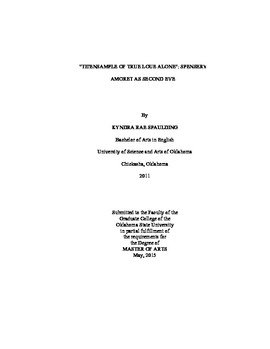| dc.contributor.advisor | Wadoski, Andrew | |
| dc.contributor.author | Spaulding, Kyndra Rae | |
| dc.date.accessioned | 2016-09-29T18:36:53Z | |
| dc.date.available | 2016-09-29T18:36:53Z | |
| dc.date.issued | 2015-05-01 | |
| dc.identifier.uri | https://hdl.handle.net/11244/45208 | |
| dc.description.abstract | C.S. Lewis once stated that, "To understand the Garden of Adonis, you have to take it along with the whole myth of Belphoebe and Amoret." This paper attempts to do just that, showing the role the Garden plays in defining the figure of Amoret in Spenser's The Faerie Queene as a second Eve figure. It looks at how Spenser uses Amoret's birth narrative, the Garden, and Busirane's Castle to form Amoret in this image, mirroring the stories of the original Eve and of Christ, the second Adam. Spenser did this in order to portray a distinctly Protestant, pro-marriage figure of womanhood and chastity in place of the Catholic privileging of Mary as a distinctly virginal "second Eve." The end result is a figure who served as "th'ensample of true loue alone," an embodiment of everything a sixteenth century Christian woman ought to be. | |
| dc.format | application/pdf | |
| dc.language | en_US | |
| dc.rights | Copyright is held by the author who has granted the Oklahoma State University Library the non-exclusive right to share this material in its institutional repository. Contact Digital Library Services at lib-dls@okstate.edu or 405-744-9161 for the permission policy on the use, reproduction or distribution of this material. | |
| dc.title | "Th'ensample of True Loue Alone": Spenser's Amoret as Second Eve | |
| dc.type | text | |
| dc.contributor.committeeMember | Jones, Edward | |
| dc.contributor.committeeMember | Eldevik, Randi | |
| osu.filename | Spaulding_okstate_0664M_13912.pdf | |
| osu.accesstype | Open Access | |
| dc.description.department | English | |
| dc.type.genre | Thesis | |
